
Earl of Shrewsbury is a hereditary title of nobility created twice in the Peerage of England. The second earldom dates to 1442. The holder of the Earldom of Shrewsbury also holds the title of Earl of Waterford (1446) in the Peerage of Ireland and Earl Talbot (1784) in the Peerage of Great Britain. Shrewsbury and Waterford are the oldest earldoms in their peerages held by someone with no higher title, and as such the Earl of Shrewsbury is sometimes described as the premier earl of England and Ireland.
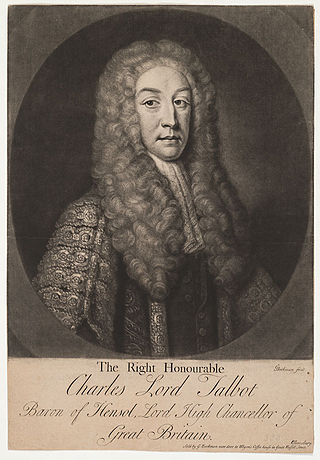
Earl Talbot is a title that has been created twice in the Peerage of Great Britain. This branch of the Talbot family descends from the Hon. Sir Gilbert Talbot, third son of John Talbot, 2nd Earl of Shrewsbury. His great-great-great-grandson, the Right Reverend William Talbot, was Bishop of Oxford, of Salisbury and of Durham. His eldest son Charles Talbot was a prominent lawyer and politician. In 1733, he was raised to the Peerage of Great Britain as Lord Talbot, Baron of Hensol, in the County of Glamorgan, and then served as Lord High Chancellor of Great Britain from 1733 to 1737.

Earl of Lonsdale is a title that has been created twice in British history, firstly in the Peerage of Great Britain in 1784, and then in the Peerage of the United Kingdom in 1807, both times for members of the Lowther family.

Viscount Massereene is a title in the Peerage of Ireland. It was created in 1660, along with the subsidiary title of Baron Loughneagh. From 1665 to 1816 the Skeffington Baronetcy of Fisherwick was attached to the viscountcy and from 1756 to 1816 the Viscounts also held the title of Earl of Massereene. Since 1843 the peerages are united with titles of Viscount Ferrard, of Oriel and Baron Oriel, both in the Peerage of Ireland, and Baron Oriel, in the Peerage of the United Kingdom. The Viscount also holds the subsidiary titles of Baron Loughneagh (1660) and Baron Oriel (1790) in the Peerage of Ireland and Baron Oriel (1821) in the Peerage of the United Kingdom. As Baron Oriel, he sat in the House of Lords until 1999.
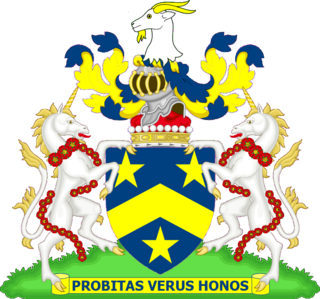
Viscount Chetwynd, of Bearhaven in the County of Kerry, is a title in the Peerage of Ireland. It was created in 1717 for Walter Chetwynd, with remainder to the issue male of his father John Chetwynd. He was made Baron Rathdowne, in the County of Dublin, at the same time, also in the Peerage of Ireland and with the same remainder. Chetwynd notably represented Stafford in the House of Commons on three occasions between 1702 and 1734, and also served as ambassador to Turin. He was succeeded according to the special remainders by his younger brother, the second Viscount, who sat as a Member of Parliament for St Mawes, Stockbridge and, from 1738 to 1747 for Stafford and served as ambassador to Madrid.

Baron Bagot, of Bagot's Bromley in the County of Stafford, is a title in the Peerage of Great Britain. It was created on 12 October 1780 for Sir William Bagot, 6th Baronet.

Baron Chetwode, of Chetwode in the County of Buckingham, is a title in the Peerage of the United Kingdom. It was created in 1945 for the noted military commander Field Marshal Sir Philip Chetwode, 7th Baronet. As of 2014 the titles are held by his grandson, the second Baron, who succeeded in 1950. He is the eldest son of Captain Roger Charles George Chetwode, who was killed in the Second World War.
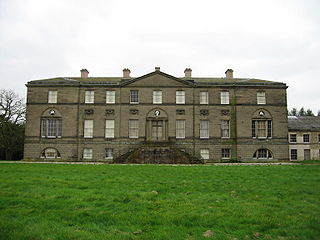
The Broughton, later Broughton-Delves, later Broughton Baronetcy, of Broughton in the County of Stafford, is a title in the Baronetage of England. It was created on 10 March 1661 for Sir Brian Broughton, of Broughton Hall, near Eccleshall, Staffordshire, High Sheriff of Staffordshire from 1660 to 1661 and the member of an ancient Staffordshire family.
There have been ten baronetcies created for persons with the surname Mackenzie, seven in the Baronetage of Nova Scotia and three in the Baronetage of the United Kingdom. Four of the creations are extant as of 2010.
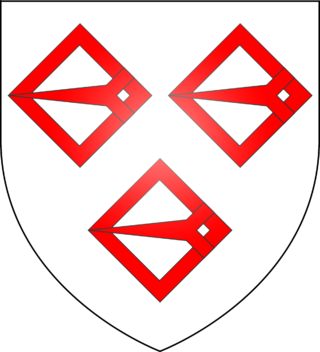
The Jerningham Baronetcy, of Cossey in the County of Norfolk, was a title in the Baronetage of England. It was created on 16 August 1621 for Henry Jerningham. The 5th Baronet married Mary Plowden, only daughter of Mary Plowden, sister of John Paul Stafford-Howard, 4th Earl of Stafford and de jure 5th Baron Stafford. He was succeeded by his son, the sixth Baron. In 1807 the claim to the barony of Stafford, which had been under attainder since 1680, passed to him through his mother. He died in 1809 when the baronetcy and the claim to the barony passed to his son, the seventh Baronet. He petitioned the House of Lords for a reversal of the attainder of the barony of Stafford and for a writ of summons to Parliament. In 1824 the attainder was reversed and the following year he was summoned to the House of Lords as the eighth Baron Stafford.

There have been two baronetcies created for members of the Hardy family, both in the Baronetage of the United Kingdom. The first creation became extinct on the death of the first baronet in 1839 and the second creation became extinct on the death of the fifth baronet in 2017.
There have been six baronetcies created for persons with the surname Brooke, one in the Baronetage of England, one in the Baronetage of Ireland and four in the Baronetage of the United Kingdom. As of 2015 four of the creations are extant, though one has been subsumed into a peerage.

There have been three baronetcies created for persons with the surname Munro, one in the Baronetage of Nova Scotia and two in the Baronetage of the United Kingdom.

Ingestre Hall is a Grade II* 17th-century Jacobean mansion situated at Ingestre, near Stafford, Staffordshire, England. Formerly the seat of the Earls Talbot and then the Earls of Shrewsbury, the hall is now owned by Sandwell Metropolitan Borough Council and is in use as a residential arts and conference centre.
This is a list of the sheriffs and high sheriffs of Staffordshire.

Brocton Hall is a building of historical significance and is listed on the English Heritage Register. It was built in 1760 by William Chetwynd and remained in the Chetwynd family until 1923 when it was sold to the Golf Club. Today the building is still used as a clubhouse and is also a venue for weddings.
The Vernon family was a wealthy, prolific and widespread English family with 11th-century origins in Vernon, Normandy, France. Their extant titles include Baron Vernon and Vernon baronets of Shotwick Park.
William Henry Chetwynd was a son of Sir George Chetwynd, 2nd Baronet. He lived at Longdon Hall, Rugeley, in Staffordshire and was involved in a sensational divorce case in 1865.

Sir George Chetwynd, 4th Baronet of Brocton Hall was the heir to the Chetwynd baronetcy upon the death of his father in 1869.
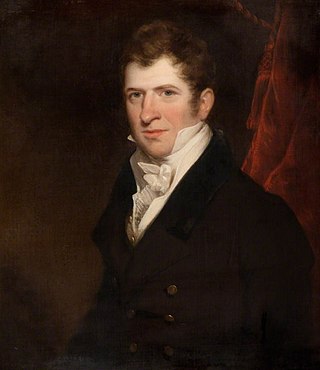
George Chetwynd (1783-1850), of Brocton Hall, near Stafford and Grendon Hall, near Atherstone, Warwickshire, was an English politician.














